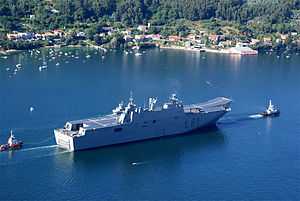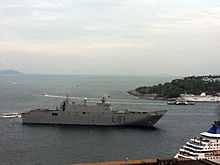Spanish ship Juan Carlos I (L61)
 Juan Carlos I on the Ría of Ferrol, October 2010 | |
| Career (Spain) | |
|---|---|
| Name: | Juan Carlos I |
| Namesake: | King Juan Carlos I of Spain |
| Ordered: | 5 September 2003 |
| Builder: | Navantia |
| Cost: | €462 million[1] (~US$600 million) |
| Laid down: | May 2005 |
| Launched: | 22 September 2009[2] |
| Sponsored by: | Queen Sofia of Spain |
| Commissioned: | 30 September 2010[3] |
| Homeport: | Naval Station Rota, Rota[4] |
| Identification: | Pennant number: L61 |
| Status: | Active as of 2015 |
| General characteristics | |
| Class and type: | Juan Carlos I class amphibious assault ship |
| Displacement: | 26,000 tonnes[5] |
| Length: | 230.82 m (757.3 ft)[6] |
| Beam: | 32 m (105 ft)[5] |
| Draught: | 6.9 m (23 ft)[6] |
| Propulsion: | 2 x 11 MW POD[5] |
| Speed: | 21 knots (39 km/h; 24 mph)[5] |
| Range: | 9,000 nautical miles (17,000 km; 10,000 mi) at 15 knots (28 km/h; 17 mph)[5] |
| Boats and landing craft carried: | Four LCM-1E |
| Capacity: | 913 soldiers + up to 46 Leopard 2E tanks |
| Complement: | Ship's company: 261[5] Air wing: 172 |
| Sensors and processing systems: | LANZA-N air search, ARIES surface search, PAR aircraft landing[5] |
| Electronic warfare and decoys: | REGULUS and RIGEL[5] |
| Armament: | 4 x 20 mm guns 4x 12.7 mm machine guns |
| Aircraft carried: | AV-8B Harrier II, F35B (future) Chinook, Sea King, NH-90 |
| Notes: | Aircraft composition:
Pure combat: 20 AV8B or F35B + 6 flight deck parking spots Mix: 11 AV8B or F35B + 12 NH90 + 6 flight deck parking spots Pure transport: 25 NH90 + 6 flight deck parking spots |
Juan Carlos I is a multi-purpose amphibious assault ship in the Spanish Navy (Armada Española). Similar in role to many aircraft carriers, the ship has a ski jump for STOVL operations, and is equipped with the AV-8B Harrier II attack aircraft. The vessel is named in honour of Juan Carlos I, the former King of Spain.[7]
The new vessel plays an important role in the fleet, as a platform that not only replaces the Newport-class LSTs Hernán Cortés and Pizarro for supporting the mobility of the Marines and the strategic transport of ground forces, but also acts as a platform for carrier-based aviation replacing the now withdrawn aircraft carrier Príncipe de Asturias.
Design
The design for the Buque de Proyección Estratégica (Strategic Projection Vessel), as it was initially known, was approved in September 2003.

The vessel has a flight deck of 202 m (663 ft), with a "ski-jump" ramp. The ship's flight deck has eight landing spots for Harrier, F-35 Lightning II or medium-sized helicopters, four spots for heavy helicopters of the CH-47 Chinook type, and one spot large enough for aircraft of V-22 Osprey size.[8] The ship can carry either 30 helicopters or 10/12 AV-8B or F-35B and 10/12 helicopters,[5] using the light vehicles bay as an additional storage zone.
For the first time in the Spanish Navy, the ship uses diesel-electric propulsion, simultaneously connecting both diesels and the new technology gas turbine powerplant to a pair of azimuthal pods.
The complement of the ship is around 900 naval personnel, with equipment and support elements for 1,200 soldiers. Multi-functional garage and hangar space on two levels covers 6,000 m2 (65,000 sq ft), with capacity for 6,000 tonnes load on each level. A stern well deck measuring 69.3 by 16.8 m (227 by 55 ft) can accommodate four LCM-1E landing craft which can beach-deliver non-swimming ground vehicles like tanks and four RHIBs, or one Landing Craft Air Cushion plus Assault Amphibious Vehicles.[9]
Construction
Construction of the 231 m (758 ft), 27,000-tonne ship started in May 2005 simultaneously at the Navantia Shipyards in Ferrol, Galicia (with the cut of the first plate corresponding to Block 320) and in Fene, Galicia (with the cut of the first plate corresponding to Block 330). The ship, that supposes a service load of 3,100,000 hours of production and 775,000 hours of engineering, was launched 10 March 2008,[10] and was commissioned 30 September 2010.[3][11] The original budget was €360 million but the ship cost €462 million (US$600 million) in the end.[1]
Exports

Australia
Following a lengthy design contest that pitted the design against the similar but smaller French Mistral-class amphibious assault ship, the Prime Minister of Australia announced on 20 June 2007, that Australia would purchase and build two ships of the same design to become the Canberra-class landing helicopter docks. Navantia was responsible for construction of the ships from the keel to the flight deck in Spain, after which the hulls were transported to Australia for completion by BAE Systems Australia. The first of these ships HMAS Canberra was commissioned in November 2014, the second ship HMAS Adelaide is due for completion in 2016.
Russia
In September 2009, Russia invited Navantia to take part in the competition to supply Russian Navy with the new generation of amphibious assault ships to compete against the French Mistral-class ships. In January 2011 Russia chose the Mistral design over the Spanish concept.
Turkey
Navantia will provide design, technology transfer, equipment and technical assistance for local construction of a derivative of the Juan Carlos-class LHD.[12][13] The Turkish Navy variant will be built in Turkey by SEDEF and feature Turkish command and control systems.[14][15][16] In December 2013, the Turkish LPD/LHD program was estimated to cost €375 million ($500 million).[17]
References
- ↑ 1.0 1.1 Ministerio de Defensa (September 2011). "Evaluación de los Programas Especiales de Armamento (PEAs)" (PDF) (in Spanish). Madrid: Grupo Atenea. Retrieved 30 September 2012.
- ↑ "El 'Juan Carlos I' sale a la mar para las primeras pruebas de navegación" (in Spanish). elCorreoGallego.es. 22 September 2009. Retrieved 5 November 2014.
- ↑ 3.0 3.1 Ministerio de defensa S.M. el Rey preside la entrega a la Armada del mayor buque de su historia
- ↑ "Navantia acaba pruebas de mar en "Juan Carlos I" y planea entrega el 24 junio" (in Spanish). finanzas.com. 2 June 2010. Retrieved 5 November 2014.
- ↑ 5.0 5.1 5.2 5.3 5.4 5.5 5.6 5.7 5.8 "LHD Juan Carlos I". Spanish Ministry of Defense (Armada). 2014. Retrieved 2014-07-10.
- ↑ 6.0 6.1 "LHD Juan Carlos I Technical data".
- ↑ Spanish Navy receives its largest warship 'Juan Carlos I'
- ↑ "LHD Juan Carlos I (Mission profile)" (in Spanish, English, and and French). Spanish Ministry of Defense (armada). 2007-10-28. Retrieved 2008-10-10.
- ↑ "Juan Carlos I Landing Helicopter Dock, Spain". Naval-Technology.com. Retrieved 29 September 2011.
- ↑ "Alonso elude concretar si el Gobierno contratará una sexta fragata F-100 para Navantia" (in Spanish). lavozdegalicia.es. 2007-10-28. Retrieved 2007-12-27.
- ↑ "El buque 'Juan Carlos I' concluye con éxito sus pruebas de mar y podrá ser entregado a la Armada el 24 de junio" (in Spanish). 20minutos.es. 2 June 2010. Retrieved 5 November 2014.
- ↑ Navantia: "Navantia and local partner selected by Turkey for construction of one LPD based on the Juan Carlos I", 27 December 2013.
- ↑ Navy Recognition: "Turkey selects Navantia's Juan Carlos LHD design as winner of its LPD tender", 28 December 2013.
- ↑ World Maritime News: "Navantia and SEDEF Join Forces to Construct LHD and LCMs for Turkish Navy", 7 January 2014.
- ↑ World Maritime News: Concept design of the Turkish variant of Juan Carlos I (L-61) class BPE
- ↑ "Turkey's Future LHD Could Be Modified as an "Aircraft Carrier" to Deploy F-35B Jets". January 2, 2015.
- ↑ "Turkey Selects Local Shipyard for LPD Contract". defensenews.com. 29 December 2013. Retrieved 5 November 2014.
External links
| Wikimedia Commons has media related to Juan Carlos I (L-61). |
- Official Web-site of the Spanish Navy (in Spanish) with information about the "Buque de Proyección Estratégica"
- Digital renderings of the finished vessel
- "Juan Carlos I under construction" (JPEG). Retrieved 2008-02-25.
- 41 photographs Juan Carlos I (L61) launch in Revista Naval (Spanish)
| ||||||